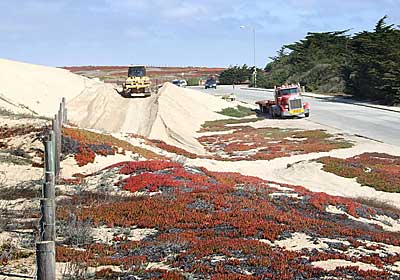
 |
|
|
|
Habitat Trust Fund producing results in Marina
December 2009  Concrete slabs are removed from the back dunes at the eastern edge of the 62-acre Marina Dunes Preserve along Dunes Drive in Marina. Photos by Tim Jensen by Steve Zmak with excepts from the Dune Habitat Restoration Plan It is the goal of the Ventana Chapter, City of Marina and Monterey Peninsula Regional Parks District (MPRPD) to work cooperatively to preserve and enhance Marina’s native coastal habitat for the enjoyment of all and as an invaluable natural asset for future generations. In 1986, the Ventana Chapter, City of Marina and the first two hotel developers in Marina’s Coastal Zone reached agreements to create the Marina Coastal Habitat Protection, Conservation, and Restoration Trust Fund as a mitigation measure to provide ongoing habitat improvements. All seven hotels in Marina’s Coastal Zone pay a 35¢ transient occupancy tax per occupied room per night into the trust fund. With accrued interest the fund has reached close to $400,000. In August 2008, MPRPD applied for a grant to partially fund their master plan for the 62-acre Marina Dunes Preserve. In April of 2009, the City and Chapter mutually agreed to grant MPRPD $75,000 to fund weed eradication, the containment of non-native trees, sand stabilization / recontouring, and the planting of native coastal species to augment the existing dune community. The Marina Dunes Preserve is located on the city’s northern border at the end of Dunes Drive and adjacent to Marina State Beach. “Ten acres of the Marina Dunes Preserve has been owned and managed by the MPRPD as a public access corridor since 1990, and in 1998, an additional 52 acres were acquired by the Big Sur Land Trust and conveyed to the Park District. “The site is located within an environmentally sensitive area known as the Marina Dunes, which includes approximately 626 acres west of Highway 1 within the City of Marina. The Marina Dunes are part of the more extensive Monterey Dunes, which extend from Monterey harbor north to the Salinas River mouth. The different geologic histories of these dunes give rise to an unusual mosaic of vegetation found nowhere else along the Pacific Coast of North America. The Monterey Dunes contain a unique blend of coastal species from northern and southern California and a large number of endemic species (native species of restricted distribution), resulting in areas of remarkable plant diversity.” Since the trust fund’s creation, it has only been accessed once, in August 2001 by the Park District, in the amount of $9,800 to implement the gateway for the Preserve. This second grant continues the Chapter’s and City’s commitment to fully realize the Park District’s vision for the Preserve. “Successful restoration will provide limited public access to an extraordinary showcase of coastal dune habitat, and provide an opportunity to connect the southern corridor of sand dunes (Marina State Beach and Fort Ord Dunes State Park, more than 1,000 acres in various stages of restoration), with quality dune habitat north to the Salinas River. Native plant species stabilize the sand with deep, extensive root systems, as well as enhance habitat quality. Plant restoration supports native wildlife populations (especially special status species) by providing a variety of species-specific food and shelter.” On September 16, 2009, the Chapter also awarded a grant of $35,100 from the Trust Fund to the City of Marina for biological surveys of the five vernal ponds within the city limits as the first phase of their restoration. The Chapter is currently reviewing a second application from the city for $52,000 for phase 2 of the restoration effort: hydrologic studies of the largest of the city’s vernal ponds (Locke-Paddon), and updating the 1994 coastal vernal pond restoration and management plan. Phase 3 will be implementation of the updated restoration plan guided by MPRPD’s vision for the Locke-Paddon Park as an active education center showcasing a variety of local coastal habitats including grassland, scrub and oak woodland. The Park District also intends to increase the trail network, install raptor boxes, and expand picnic and passive recreation areas. Excerpts from the Dune Habitat Restoration Plan, Marina Dunes Preserve, prepared by Joey Dorrell-Canepa, Native Solutions, San Juan Bautista, CA are used in this article. These excerpts are indicated by quotation marks and italic type.
< back to all issues |
|